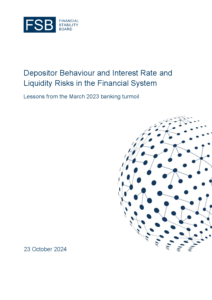Press enquiries:
+41 61 280 8477
[email protected]
Ref: 24/2024
- FSB analysis finds life insurers, non-bank real estate investors, and a weak tail of banks to be most vulnerable to the confluence of solvency and liquidity risks.
- Technological developments and social media could accelerate future bank runs, with implications for liquidity risk management practices and supervision.
- Report calls on bank managers and financial sector authorities to address the liquidity and solvency vulnerabilities that give rise to extreme deposit outflows and to be able to react much more quickly to deposit outflows than in the past.
The Financial Stability Board (FSB) published today a report on depositor behaviour and interest rate and liquidity risks in the financial system, drawing on lessons from the March 2023 banking turmoil.
This report summarises the main findings from FSB work over the past year to assess vulnerabilities in the global financial system related to solvency and liquidity risks amid rising interest rates, the influence of technology and social media on depositor behaviour during bank runs, and how the use of technologies may affect the planning and execution of a resolution.
The analysis identifies life insurers, non-bank real estate investors – comprising real estate investment trusts, real estate funds, and other nonbank mortgage lenders – as well as a weak tail of banks as most vulnerable to solvency and liquidity risks at the current juncture. These entity types typically have a high proportion of interest rate-sensitive assets and liabilities and are affected by higher rates through various solvency and liquidity risk channels.
Some of the deposit runs that took place in March 2023 unfolded at an unprecedented speed. The three fastest deposit runs had outflows of around 20-30% per day, which was faster than the highest peak one-day outflow of past deposit runs reported by FSB members. The scale of deposit runs, as a share of pre-run deposits, was in the upper range of outflows seen in past runs. Banks experiencing the runs tended to have an unusually high reliance on uninsured deposits, while the concentration of the deposit base likely played a role in the large outflows.
There is some evidence that social media had an influence on some of the recent bank runs, though the depositor categories at the centre of those runs are likely to have had access to other information sources. Technological advancements have facilitated an easier and faster transfer of deposits in recent years, which may have made depositors more willing to move funds between banks.
The findings in the report raise issues that are relevant for bank managers, supervisors, regulators, resolution authorities and policy makers. The speed of the recent runs means that banks and authorities may need to be able to react much more quickly to deposit outflows than in the past; find ways to address the liquidity and solvency vulnerabilities that gave rise to such extreme outflows; and consider whether monitoring of social media could be helpful as an early warning tool to flag potential stress at a bank or wider turmoil that might affect banks. Consideration could also be given to collecting and publishing additional information on bank deposits and on unrealised losses on bank securities portfolios to fill identified data gaps.
The possibility of further rapid deposit runs in the future also raises challenges for authorities’ ability to execute a resolution. Authorities and banks should enhance their operational readiness for resolution and incorporate effective communication strategies to ensure coordinated and consistent messaging.
Notes to editors
The FSB provided an overview of the March 2023 banking turmoil and follow-up work in its October 2023 Annual Report on Promoting Global Financial Stability. It also issued a report in October 2023 on preliminary lessons learnt for resolution from the 2023 bank failures.
The FSB coordinates at the international level the work of national financial authorities and international standard-setting bodies and develops and promotes the implementation of effective regulatory, supervisory, and other financial sector policies in the interest of financial stability. It brings together national authorities responsible for financial stability in 24 countries and jurisdictions, international financial institutions, sector-specific international groupings of regulators and supervisors, and committees of central bank experts. The FSB also conducts outreach with approximately 70 other jurisdictions through its six Regional Consultative Groups.
The FSB is chaired by Klaas Knot, President of De Nederlandsche Bank. The FSB Secretariat is located in Basel, Switzerland and hosted by the Bank for International Settlements.
